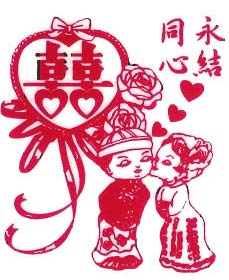
Red is the Color of Weddings in China
Red is central to the wedding theme of China. It signifies love, joy and prosperity. The bride's wedding down is often red, as are the wedding invitations, and wedding gift boxes or envelopes for cash gifts.
Before the Chinese Wedding Day
Before her wedding celebration, a Chinese bride traditionally goes into seclusion with her closest friends. This Chinese custom gives the bride-to-be some time to symbolically mourn the loss of her friends and family.
Some time before the couple are married, the groom's family carries wedding gifts in red baskets and boxes to the bride's house. One of the baskets will contain "uang susu" or 'milk money'. Others will contain personal things for the bride, so that on her wedding day all of her personal belongings will be in the groom's house. The bride takes the gifts to another room where they are sorted through. Three days before the wedding day, women from the bride's family reciprocate, bearing gifts -- including some 'returns'-- in red wrappings to the groom's family.
The Day of the Wedding Ceremony
Wedding anniversaries in China, are carefully chosen according to astrological signs. It is also customary for couples to be married on the half-hour or their wedding day rather than at the top of the hour. In this way, the couple begins their new lives together on an 'upswing', while the hands of the clock are moving up, rather than down.
On the morning of his wedding day, the groom is symbolically dressed by his parents. The groom arrives at the house of his bride on the way to the wedding chapel. He brings gifts of cash, wrapped in red tissue, to give to his bride's friends, in exchange for 'letting her go'. In some families, the wedding couple serves tea to both sets of parents while kneeling in front of them. a symbolic gesture of asking for permission. The bride and groom then leave for the wedding site together.
Chinese Marriage Ceremony and Wedding Reception
The wedding ceremony is usually attended only by the couples' immediate families. Just after the ceremony and before the wedding reception, the bride who honors tradition will serve tea to her in-laws in a formal ceremony. The couple will usually go to a professional studio for wedding pictures before they proceed to their reception. The wedding reception, an elaborate standing only affair.

A welcoming speech is usually performed by an MC who is hired for the occasion. The speech is followed by a cake cutting ceremony. The traditional wedding cake is immense, with many layers. The layers symbolize a ladder that they couple will 'climb to success', so couples will cut the cake from the bottom and work their way up. The cutting of the cake is the only event of the reception. The bride and groom feed each other a piece of cake with arms entwined, trying not to destroy the bride's elaborate makeup. A piece is then cut for each of the parents and for the grandparents, who are fed by the bride and groom holding the cake together. Sometimes a wedding toast is given and guests are invited to greet the newlyweds and their parents. Musical entertainment, which ranges from a simple keyboard player to a symphony or orchestra, accompanies the receiving line It is customary for guests to shake hands again before leaving the reception. At more elaborate Chinese weddings, a sit-down reception may feature a 9 or 10 course meal as well as musical entertainment.
Chinese brides often change outfits at least three times during the reception.









